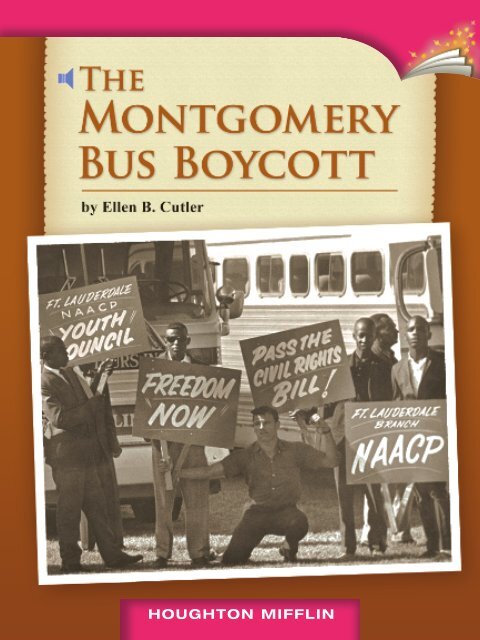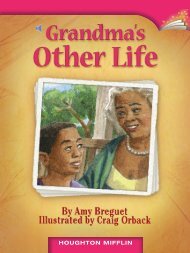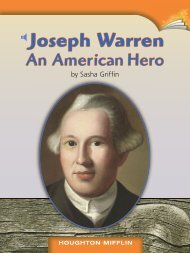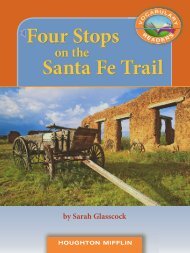Lesson 24:The Montgomery Bus Boycott
Lesson 24:The Montgomery Bus Boycott
Lesson 24:The Montgomery Bus Boycott
- No tags were found...
You also want an ePaper? Increase the reach of your titles
YUMPU automatically turns print PDFs into web optimized ePapers that Google loves.
HOUGHTON MIFFLIN
<strong>The</strong><strong>Montgomery</strong><strong>Bus</strong> <strong>Boycott</strong>by Ellen B. CutlerPHOTOGRAPHY CREDITS: Cover © Bettmann / Corbis; 1 © Bettmann / Corbis; 2 © Time & Life Pictures / Getty Images; 3 ©Bettmann / Corbis; 4 © Bettmann / Corbis; 6 © Flip Schulke / Corbis; 9 © Bettmann / Corbis; 10 © Steve Schapiro / Corbis;11 © Corbis; 12 © Bettmann / Corbis; 13 © Bettmann / Corbis; 14 © Bettmann / CorbisCopyright © by Houghton Mifflin Harcourt Publishing CompanyAll rights reserved. No part of this work may be reproduced or transmitted in any form or by any means, electronic ormechanical, including photocopying or recording, or by any information storage and retrieval system, without the priorwritten permission of the copyright owner unless such copying is expressly permitted by federal copyright law. Requestsfor permission to make copies of any part of the work should be addressed to Houghton Mifflin Harcourt School Publishers,Attn: Permissions, 6277 Sea Harbor Drive, Orlando, Florida 32887-6777.Printed in ChinaISBN-13: 978-0-547-02874-3ISBN-10: 0-547-02874-11 2 3 4 5 6 7 8 0940 18 17 16 15 14 13 12 11If you have received these materials as examination copies free of charge, Houghton Mifflin Harcourt School Publishersretains title to the materials and they may not be resold. Resale of examination copies is strictly prohibited.Possession of this publication in print format does not entitle users to convert this publication, or any portion of it, intoelectronic format.
What would happen if African Americans in<strong>Montgomery</strong> stopped taking the bus? Would peopleeven agree to boycott the buses? Could AfricanAmericans “walk their way to equality?” <strong>The</strong>y wereabout to find out.Rosa ParksThursday, December 1, 1955, began as anordinary day. An African American woman namedRosa Parks got on a bus in <strong>Montgomery</strong>. She washeaded home from work. She took a seat halfwaydown the bus. Three other African Americans werein the same row. It was the first row that black peoplewere allowed to sit in.At another stop, a white man boarded the bus.<strong>The</strong>re were no seats left up front where white peoplesat. <strong>The</strong> bus driver told everyone in Parks’ row tomove so the white man would not have to sit nextto them. <strong>The</strong> other passengers in Parks’ row moved.Parks refused to give up her seat. <strong>The</strong> bus driver calledthe police. Rosa Parks was arrested and taken to jail.Throughout it all, she remained calm and serene.News of her arrest spread quickly.Rosa Parks played a key rolein the Civil Rights movement.5
Joining the EffortWhen Jo Ann Robinson heard about Rosa Parks’arrest, she called for a one-day boycott of the buses.Robinson was a member of the Women’s PoliticalCouncil of <strong>Montgomery</strong>. <strong>The</strong> group called a meeting.Hundreds of people came. Many of them wereministers. That Sunday, the ministers asked theirchurch members to join the boycott.One of the ministerswas Dr. Martin LutherKing, Jr. He helpedform a group calledthe <strong>Montgomery</strong>ImprovementAssociation (MIA).<strong>The</strong> group decidedto try to keep theboycott going longer.<strong>The</strong> one-day boycotthad been successful.Suddenly, the streetsof <strong>Montgomery</strong> werefull of people walkingto work.6
Jo Ann Robinson<strong>The</strong> Women’s Political Council of<strong>Montgomery</strong> (WPC) had wanted a busboycott for a long time. In 1954, JoAnn Robinson and the WPC had askedthe city to end bus segregation laws.Nothing happened.When the police arrested Rosa Parks,Robinson wrote a leaflet. She called for aboycott. <strong>The</strong> leaflet said, “If we do not dosomething to stop these arrests, they willcontinue. <strong>The</strong> next time, it may be you,or your daughter, or mother.”Robinson helped keep the boycottgoing. It was a risk to do so. She wasa professor at Alabama State College.She could have lost her job for helpingthe boycott.Dr. King became anational leader of theCivil Rights movement.7
Why Did the <strong>Boycott</strong>Happen at this Time?Rosa Parks’ decision not to give up herseat was one of the first important events ofthe Civil Rights movement. <strong>The</strong> Civil Rightsmovement was an effort to end segregationand gain equal rights for African Americans.From the point of view of <strong>Montgomery</strong>’sblack leaders, Rosa Parks was the right personat the right time. <strong>The</strong>y needed the AfricanAmerican community to get angry enoughto support a boycott. A bus boycott wouldshow that the segregation laws were unfair.Parks was the perfect person. She was aneducated person who always obeyed thelaws. She was a distinguished member of thecommunity. After her arrest, Parks agreed tohelp the cause further.<strong>The</strong> <strong>Boycott</strong> Continues<strong>The</strong> one-day boycott stretched into a week. <strong>The</strong>nit lasted a month, then many months, and then a year.For 381 days, most of the city’s black citizens — andsome white citizens — refused to ride the buses.8
Many people fought toend discrimination.Some taxi drivers helped people who used to ridethe buses. <strong>The</strong>y charged less for a ride than the usualfare. People who owned cars helped, too. <strong>The</strong>se carswere called “MIA taxis.” <strong>The</strong> MIA told the driverswhen and where to pick people up.9
<strong>The</strong> Effects of the <strong>Boycott</strong>A boycott can be a good way to bring aboutchange, but it is not easy. Many African Americanslost their jobs. Some could not get to work anymore.Others lost their jobs because they took part in theboycott. Companies also lost money because AfricanAmericans were not shopping in downtown stores.Some white citizens wanted to hurt the city’sAfrican American leaders. A few even set fire to blackleaders’ homes. <strong>The</strong> city tried to stop the boycott.<strong>The</strong>re was an old law against boycotts. Leaders of theboycott were arrested and sent to jail.<strong>The</strong> boycott put many peoplein danger.10
<strong>The</strong> Women of the <strong>Boycott</strong>Women were key to the success of the busboycott. <strong>The</strong>se regal ladies were poor, but theywere as proud as queens.Georgia Gilmore lost her job when she joinedthe boycott. She started a group that baked andsold pies, cookies, and cakes. <strong>The</strong> money thewomen raised helped fund the boycott.Many women supported the boycott.Dr. Martin Luther King, Jr. wrote about some ofthese women in his books. One, a woman called“Mother Pollard,” was old and poor. Even so, shestopped taking the bus. She kept on walking andsaid, “My feet’s tired, but my soul is rested.”11
12<strong>The</strong> Supreme Court also ruled that schoolscould not keep blacks and whites separate.
<strong>The</strong> <strong>Boycott</strong> EndsIn the end, the <strong>Montgomery</strong> <strong>Bus</strong> <strong>Boycott</strong> was asuccess. <strong>The</strong> Supreme Court ruled that segregation onthe buses went against the U.S. Constitution. So, thebuses could not be segregated anymore. <strong>Montgomery</strong>’sAfrican Americans started riding the buses again onDecember 21, 1956. It was more than a year after theboycott began.This ruling had great significance. People workingfor civil rights were overjoyed. It was clear that otherkinds of segregation would soon have to end.Compare this photo to the one on page 3.13
<strong>The</strong> <strong>Montgomery</strong> <strong>Bus</strong> <strong>Boycott</strong> was animportant victory for civil rights.Changing the law, though, was easier thanchanging people’s minds. <strong>The</strong> government had to stepin many more times to put an end to segregation. Ittook years for all Americans to gain equal rights.<strong>The</strong> <strong>Montgomery</strong> <strong>Bus</strong> <strong>Boycott</strong> was just one step,but it was a big one. America was now on a true pathto freedom!14
RespondingTARGET SKILL Author’s Purpose Thisbook informs readers about a key event in U.S.history. That was the author’s purpose. Copy thechart below. Add two reasons why the authorbelieves this event was important.Segregationended onthe buses.? ?Purpose: Tell about a key event in U.S. history.Write About ItText to Text Rosa Parks helped changed history.Think of a person you read about who alsochanged history. Make a list of how he or shedid it. <strong>The</strong>n write a paragraph explaining howhe or she changed history.15
TARGET VOCABULARYagitationconceivecontroversydistinguishedecstasyinclinedprejudiceregalserenesignificanceTARGET SKILL Author’s Purpose Use textdetails to figure out the author’s viewpoint andreasons for writing.TARGET STRATEGY Question Ask questionsabout a selection before you read, as you read, andafter you read.GENRE Narrative Nonfiction gives factualinformation by telling a true story.Write About ItIn a famous quotation, Aung San Suu Kyi said,“Please use your freedom to promote ours.”What freedoms do you value most? Why? Writea letter to the editor of a Burmese newspaperexplaining the freedoms you have and why theyare important to you.16
Level: TDRA: 44Genre:Narrative NonfictionStrategy:QuestionSkill:Author’s PurposeWord Count: 1,4326.5.<strong>24</strong>HOUGHTON MIFFLINOnline Leveled Books1032991

















